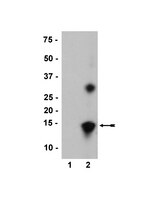Alpha-synuclein: its biological function and role in neurodegenerative diseases.
Kaplan, Batia, et al.
J. Mol. Neurosci., 20: 83-92 (2003)
2003
Show Abstract
Alpha-synuclein is regarded as a presynaptic protein, which may play an important role in neuronal plasticity. However, the actual physiological function of this protein is not completely clear. Abnormal accumulation of fibrillar alpha-synuclein in Lewy bodies, as well as mutations in the alpha-synuclein gene identified in the familial forms of Parkinson's disease, point to a central role of this protein in the pathophysiology of Lewy body-related disorders. In vivo and in vitro studies showed that overexpression of alpha-synuclein, its aggregation, and interaction with other proteins are the most critical factors affecting the survival of neurons. In Alzheimer's disease, the amount of alpha-synuclein is found to be elevated at synapses, whereas a peptide derived from alpha-synuclein is thought to represent an intrinsic component of amyloid plaques. It is likely that in this disorder alpha-synuclein plays a dual role by being involved not only in synaptic function but also in amyloid beta-fibrillogenesis. | | 12794302
 |
Oxidative modifications of alpha-synuclein.
Ischiropoulos, Harry
Ann. N. Y. Acad. Sci., 991: 93-100 (2003)
2003
Show Abstract
Hallmark lesions of neurodegenerative synucleinopathies contain alpha-synuclein (alpha-syn) that is modified by nitration of tyrosine residues and possibly by dityrosine cross-linking to generated stable oligomers. Data gathered from in vitro experiments and from model systems of cells transfected with wild-type and mutant alpha-syn revealed that conditions resulting in alpha-syn nitration also induce formation of alpha-syn inclusions with similar biochemical characteristics to protein extracted from human lesions. The detection of tyrosine-nitrated alpha-syn signifies the formation of reactive nitrogen species capable of both radical and electrophilic attack on aromatic residues as well as nucleophilic additions and oxidations. The cellular sources and biochemical reactivity of reactive nitrogen species in the central nervous system remain largely unknown, but kinetically fast reactions of nitric oxide with superoxide to form peroxynitrite as well as enzymatic one-electron oxidation of nitrite are two important sources of reactive nitrogen species. Based on these findings a model is proposed where the process of fibrilization can be differentially affected by oxidants and nitrating species. Posttranslational modifications of alpha-syn by reactive nitrogen species inhibits fibril formation and results in urea- and SDS- insoluble, protease-resistant alpha-syn aggregates that maybe responsible for cellular toxicity. | | 12846977
 |
Development of new treatments for Parkinson's disease in transgenic animal models: a role for beta-synuclein.
Masliah, Eliezer and Hashimoto, Makoto
Neurotoxicology, 23: 461-8 (2002)
2002
Show Abstract
Neuronal death in Parkinson's disease (PD), one of the most common neurodegenerative disorders in the adult and aging population is probably caused by misfolding of synaptic proteins such as alpha-synuclein. Although, some treatments are currently available to control some of the symptoms of PD, none of these approaches directly addresses the mechanisms of disease. With the advent of new experimental animal models for this disorder, the potential for development and discovery of new treatment has been significantly bolstered. Among them, overexpression of alpha-synuclein results in motor deficits. dopaminergic loss and formation of inclusion bodies. Co-expression of mutant amyloid precursor protein, accelerates alpha-synuclein aggregation and enhances the neurodegenerative pathology in these mice, providing a unique model where to investigate the interactions between Abeta1-42 and alpha-synuclein and to develop treatments for combined Alzheimer's disease and PD. Development of anti-parkinsonian treatments based on these models includes: (i) anti-aggregation or pro-degradation compounds, (ii) neuroprotective compounds, and (iii) neurotrophic agents. Among them, we characterized beta-synuclein, the non-amyloidogenic homologue of alpha-synuclein, as an inhibitor of aggregation of alpha-synuclein. Our results raise the intriguing possibility that beta-synuclein might be a natural negative regulator of alpha-synuclein aggregation, and that a similar class of endogenous factors might regulate the aggregation state of other molecules involved in neurodegeneration. Such an anti-amyloidogenic property of beta-synuclein might also provide a novel strategy for the treatment of neurodegenerative disorders. | | 12428718
 |
Dityrosine cross-linking promotes formation of stable alpha -synuclein polymers. Implication of nitrative and oxidative stress in the pathogenesis of neurodegenerative synucleinopathies.
Souza, J M, et al.
J. Biol. Chem., 275: 18344-9 (2000)
2000
Show Abstract
Intracellular proteinaceous aggregates are hallmarks of many common neurodegenerative disorders, and recent studies have shown that alpha-synuclein is a major component of several pathological intracellular inclusions, including Lewy bodies in Parkinson's disease (PD) and glial cell inclusions in multiple system atrophy. However, the molecular mechanisms underlying alpha-synuclein aggregation into filamentous inclusions remain unknown. Since oxidative and nitrative stresses are potential pathogenic mediators of PD and other neurodegenerative diseases, we asked if oxidative and/or nitrative events alter alpha-synuclein and induce it to aggregate. Here we show that exposure of human recombinant alpha-synuclein to nitrating agents (peroxynitrite/CO(2) or myeloperoxidase/H(2)O(2)/nitrite) induces formation of nitrated alpha-synuclein oligomers that are highly stabilized due to covalent cross-linking via the oxidation of tyrosine to form o,o'-dityrosine. We also demonstrate that oxidation and nitration of pre-assembled alpha-synuclein filaments stabilize these filaments to withstand denaturing conditions and enhance formation of SDS-insoluble, heat-stable high molecular mass aggregates. Thus, these data suggest that oxidative and nitrative stresses are involved in mechanisms underlying the pathogenesis of Lewy bodies and glial cell inclusions in PD and multiple system atrophy, respectively, as well as alpha-synuclein pathologies in other synucleinopathies. | | 10747881
 |




















